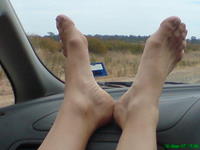 The last couple of weeks have seen me hitting the roads of New South Wales, so I thought I’d share a couple of observations to help a few of you first timers out there. While I do enjoy a good road trip and certainly enjoy getting out to see this country, there are a few things of which you should be aware. First in a series to come.
The last couple of weeks have seen me hitting the roads of New South Wales, so I thought I’d share a couple of observations to help a few of you first timers out there. While I do enjoy a good road trip and certainly enjoy getting out to see this country, there are a few things of which you should be aware. First in a series to come.
General Road Conditions: The weather being mostly temperate, the roads of Australia are basically in pretty good shape. The paving is generally smooth and the gravel roads are generally grated to allow for decent, if not great, travel. I’ve definitely driven on worse. That said, I find them unnecessarily winding. This is the source of much debate from the passengers in my car and myself as to whether winding roads/major interstates are more fun to drive on or just plain dangerous. I will point to the fact that the government here can’t figure out why they have so many accidents, maybe it is because there is a 90 degree turn on a major interstate that is two lanes wide that trucks have to navigate at high speed????? (an exaggeration of course, the turn was only 87.5 degrees with a round-about just after….) While the road rules are basically the same, driving is FAR more challenging here than in North America and most parts of Europe.
Passing: There are very few of what would be considered major highways. I regularly get annoyed trying to get out of Sydney on what is considered the M1 as I sit at a stop light. On some of the smaller motorways, there are only two lanes. Occasionally the RTA (Highway Authority) will add a third lane on the outside of the highway for slower traffic to move into so others may pass. This third lane will generally end with little to no warning and the slower traffic has to merge back into the original lane. Keep very aware during this maneuver. Passing and no-passing zones are marked with the international broken or unbroken center line.
Slow Lane/Fast Lane: The speed limits on the highways are incredibly slow compared to most international standards, normally not more than 100 or 110 Kilometers an hour. Slow traffic move to the left, the inside lanes to the right are for faster traffic and overtaking. For all of you who grew up driving on the right side of the road, this will seem very strange.
Speed Cameras: Instead of police hiding on the side of the road to spank you for speeding, the Aussies like their speed cameras. There are generally signs warning you of the speed cameras, and it seems like you must be a fool to get caught, but from personal experience, it most definitely happens. Read all road signs, watch for school zones, and stop to rest regularly to keep yourself aware and alert.
 Hazards: The wildlife is a major road hazard here. Try not to drive at dawn and dusk, as that is when most of the wildlife is most active. In the States I would regularly drive 10-12 hours overnight, for long stretches without stopping. That is a very bad idea here. The roads are narrow, winding, and a wombat will take out a very substantial chunk of your car. And besides, how bad would you feel hitting a Koala or Kangaroo? In high wildlife areas there are road signs with telephone numbers to call if you injure the wildlife. A Kangaroo is almost always pregnant, so if you hit one, they will try and come save the baby.
Hazards: The wildlife is a major road hazard here. Try not to drive at dawn and dusk, as that is when most of the wildlife is most active. In the States I would regularly drive 10-12 hours overnight, for long stretches without stopping. That is a very bad idea here. The roads are narrow, winding, and a wombat will take out a very substantial chunk of your car. And besides, how bad would you feel hitting a Koala or Kangaroo? In high wildlife areas there are road signs with telephone numbers to call if you injure the wildlife. A Kangaroo is almost always pregnant, so if you hit one, they will try and come save the baby.
There are loads more road observations. Please feel free to add a few of your own experiences/observations in the comment section.
Guide #2